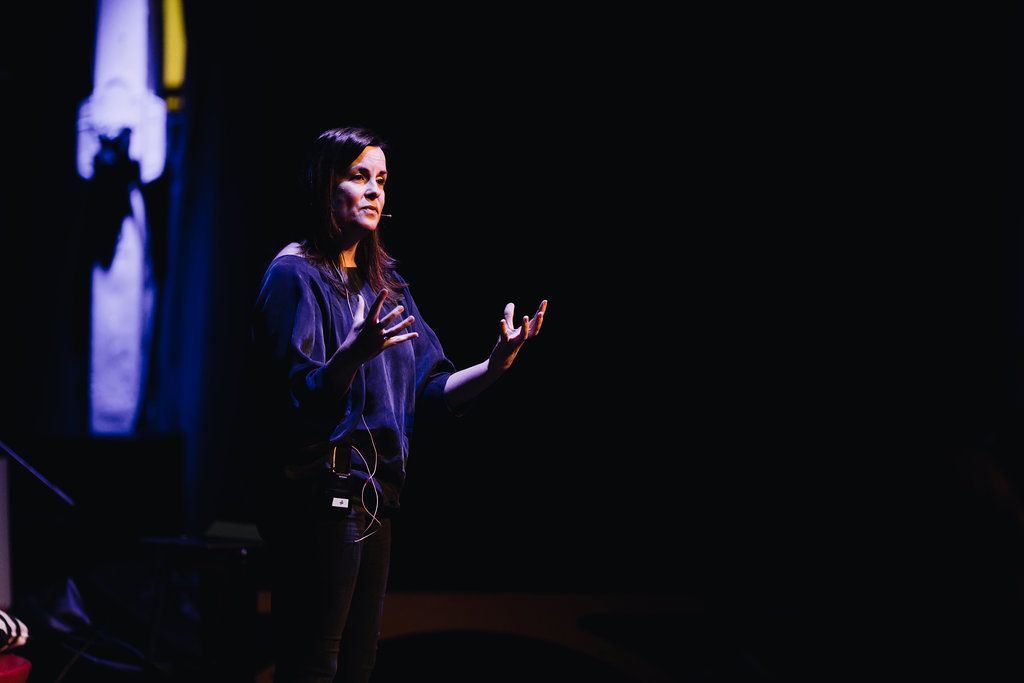Swinburne alum pioneering human-centred design

Swinburne alum Melis Senova has dedicated her career to using design to positively affect humanity, a journey that started when she first watched Top Gun as a 10-year-old.
In summary
- Swinburne alum Melis Senova has dedicated her life to using design to positively affect humanity
- Melis is a neuroscientist, published author, designer, entrepreneur, and leadership coach
- She is the author of two books that equip designers to be the person who is designing for others
Anyone growing up in the eighties will remember when Top Gun was released. For Swinburne alum Melis Senova, who was 10 years old at the time, Top Gun was more than just an iconic movie – it was the catalyst for her path in life.
The scene that particularly struck Melis was watching Top Gun instructor Charlotte (call sign Charlie) Blackwood being introduced to Maverick and the other naval aviators as a world-leading expert in enemy aircraft, with a PhD in astrophysics and trusted by the likes of the Pentagon.
“I remember looking at that woman standing in front of the world’s best fighter pilots teaching them how to be better and thought, ‘I want to be her,’” says Melis.
“I wanted to be someone who was qualified to stand in front of the world’s best and have something to offer and teach them.”
Today, Melis is a published neuroscientist, author, designer, entrepreneur and leadership coach.

Melis started a strategic design consulting firm with her partner, to help organisations understand why considering humans as part of their design is fundamental.
Becoming Charlie
After finishing high school, Melis chose to study a Bachelor of Applied Sciences (Biomedical Engineering) at Swinburne, majoring in neuroscience, to combine her interests in aerospace and medicine.
She jumped at the opportunity to study abroad for her Industry-Based Learning year, working in a research hospital in Japan that specialised in brain imaging.
“That really launched the research part of my career, as I was able to publish papers about the work I did there,” says Melis.
When she returned, one of Melis’ professors approached her about undertaking a PhD. Responding to her initial scepticism, he asked Melis, ‘If you could be anyone in the world, who would you be?’ ‘Charlie from Top Gun,’ Melis replied.
With a Swinburne Postgraduate Scholarship to support her, she and her professor approached the (now) Australian Defence Science Technology Group. The following year, Melis started her graduate job and PhD there, working with FA18 and F1-11 pilots to inform the redesign of cockpit environments to improve situational awareness in pilots flying twice the speed of sound.
“It was like a dream come true,” says Melis.
Design and humanity
That sparked a career trajectory for Melis centred around using design to positively affect humanity.
After her PhD, Melis worked as a design engineer at Ford where she successfully advocated for and designed the first Australian-manufactured rear camera for the Ford Territory.
“It was a real design challenge because you had to do it at no added cost, using current parts and without any changes to the sheet metal.”
From there, Melis went on to lead a team of psychologists, designers and developers in Telstra’s Chief Technology Office, creating prototypes to demonstrate user experiences enabled by emerging technologies.
In 2009, Melis took a leap, and started a strategic design consulting firm, Huddle, with her partner, Cam Incoll.
“The intention of Huddle was to help organisations understand why considering humans as a part of the systems they’re designing is fundamental, good for business, and good for caring about customers.”
For 12 years, Huddle worked with all kinds of organisations, including helping social enterprise Streat go from their first coffee cart to their café.

Melis' second book will be released this year and is all about equipping designers to design better for others.
Equipping people to design with others
As Melis progressed in her career, it became apparent to her that there were no resources for designers to help them improve themselves, so they could design with others better.
In 2016, while living in Amsterdam, she published this human – a book about what it takes to be the person who is doing the designing in human-centred design.
“I had learnt…that the best designers were the ones who had the most developed understanding of themselves, their biases and how their personalities and world views affected how and what they designed.”
In April, Melis will launch her second book – this human - design character – which follows on from her first book to help designers develop the attributes and inner scaffolding to be potent, confident and influential designers.
Design on a global scale
Today, Melis is focused on building the this human community, which includes projects, coaching and mentoring. “At this point of my life, my work is about supporting the world builders and creators.”
Her work has taken her to the furthest corners of the world, from New York to Chennai, and from Amsterdam to Aruba.
After publishing her first book, Melis received an email from the Chief Innovation Officer in the Aruban government asking about the possibility of collaboration.
“It came out of the blue and difficult to believe at first…and I’ve been working with them ever since,” says Melis.
She has worked with the government to guide human-centred design-led economic diversification for their nation, supporting the transition from being reliant on tourism and hospitality to one of entrepreneurship and innovation. That has led to opportunities for mentoring and coaching of a diverse group of people, from up-and-coming independent female entrepreneurs to senior officials within industry and government. Her work in Aruba continues as they look at the intersection of social housing, renewable energy and systemic design.
Creating for the future
Melis is now back home in Melbourne, where she lectures in Swinburne’s Master of Design program. She says it is an exciting time to be stepping into the design industry.
“People opting into creative careers – or anyone thinking about how to create for the future – they are really important people right now.”
“It is a very important responsibility because we can’t continue to design things unconsciously and replicate the systems we already have because they’re not working. They all require resources to be dug out of the ground and don’t head down a path that is regenerative.
“This is the time when we have the opportunity to be the most creative as a human species.”
Find out more about Melis on her website. You can also buy both of her books online.
-
Media Enquiries
Related articles
-

- Design
Swinburne alum launches zine celebrating Asian Australian art and identity
Swinburne Graphic Design alum Dan Truong founded HOISZN, a zine publication showcasing Asian Australian artists and their work.
Monday 01 July 2024 -

- Design
Swinburne students shine in lighting design collaboration
Swinburne students collaborated with About Space Lighting, resulting in several student-designed lamps being put into production.
Friday 07 June 2024 -

- University
Swinburne University of Technology partners with Grande Experiences and THE LUME Melbourne for cutting-edge Immersive Media education
Swinburne University of Technology is proud to announce its partnership with Grande Experiences and THE LUME Melbourne, enhancing the future of Immersive Media education.
Thursday 13 June 2024 -

- Design
Yarra Trams feature Women in Trades campaign designed by Swinburne students
School of Design and Architecture students in Swinburne’s Bureau collaborated with Tradeswomen Australia Group to design a tram wrap celebrating women in trades.
Thursday 16 May 2024 -

- Design
- Astronomy
- Technology
- University
Swinburne ‘Rock Muncher’ takes part in Australian Rover Challenge
A multidisciplinary student team from Swinburne University of Technology competed in the 2024 Australian Rover Challenge held in Adelaide, South Australia.
Thursday 11 April 2024

